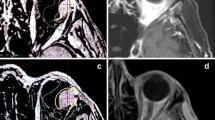Abstract
Background
We present our experience in treating ocular melanoma at the National Centre for Stereotactic Radiosurgery in Sheffield, UK over the last 20 years.
Method
We analysed 170 patients treated with Gamma Knife radiosurgery, recorded the evolution of visual acuity and complication rates, and compared their survival with 620 patients treated with eye enucleation. Different peripheral doses (using the 50% therapeutic isodose) were employed: 50-70 Gy for 24 patients, 45 Gy for 71 patients, 35 Gy for 62 patients.
Findings
There was no significant difference in survival between the 35-Gy, 45-Gy and 50– to 70-Gy groups when compared between themselves (p = 0.168) and with the enucleation group (p = 0.454). The 5-year survival rates were: 64% for 35 Gy, 62.71% for 45 Gy, 63.6% for 50–70 Gy and 65.2% for enucleated patients. Clinical variables influencing survival for radiosurgery patients were tumour volume (p = 0.014) and location (median 66.4 vs 37.36 months for juxtapapillary vs peripheral tumours, respectively; p = 0.001), while age and gender did not prove significant. Regarding complications, using 35 Gy led to more than a 50% decrease, when compared with the 45-Gy dose, in the incidence of cataract, glaucoma and retinal detachment. Retinopathy, optic neuropathy and vitreous haemorrhage were not significantly influenced. Blindness decreased dramatically from 83.7% for 45 Gy to 31.4% for 35 Gy (p = 0.006), as well as post-radiosurgery enucleation: 23.9% for 45 Gy vs 6.45% for 35 Gy (p = 0.018). Visual acuity, recorded up to 5 years post-radiosurgery, was significantly better preserved for 35 Gy than for 45 Gy (p = 0.0003).
Conclusions
Using 35 Gy led to a dramatic decrease in complications, vision loss and salvage enucleation, while not compromising patient survival.



Similar content being viewed by others
References
Augsburger JJ, Correa ZM, Freire J, Brady LW (1998) Long-term survival in choroidal and ciliary body melanoma after enucleation versus plaque radiation therapy. Ophthalmology 105:1670–1678
Cohen VM, Carter MJ, Kemeny A, Radatz M, Rennie IG (2003) Metastasis-free survival following treatment for uveal melanoma with either stereotactic radiosurgery or enucleation. Acta Ophthalmol Scand 81:383–388
Collaborative Ocular Melanoma Study Group (2001) The COMS randomized trial for iodine 125 brachytherapy for choroidal melanomas III. Initial mortality findings. Arch Ophthalmol 119:969–981
De Potter P, Shields CL, Shields JA, Cater JR, Tardio DJ (1994) Impact of enucleation versus plaque radiotherapy in the management of juxtapapillary choroidal melanoma on patient survival. Br J Ophthalmol 78:109–114
Fakiris AJ, Lo SS, Henderson MA, Witt TC, Worth RM, Danis RP, Des Rosiers PM, Timmerman RD (2007) Gamma-knife-based stereotactic radiosurgery for uveal melanoma. Stereotact Funct Neurosurg 85:106–112
Furdova A, Slezak P, Chorvath M, Waczulikova I, Sramka M, Kralik G (2010) No differences in outcome between radical surgical treatment (enucleation) and stereotactic radiosurgery in patients with posterior uveal melanoma. Neoplasma 57:377–381
Furdova A, Strmen P, Waczulikova I, Chorvath M, Sramka M, Slezak P (2011) One-day session LINAC-based stereotactic radiosurgery of posterior uveal melanoma. Eur J Ophthalmol
Krema H, Somani S, Sahgal A, Xu W, Heydarian M, Payne D, McGowan H, Michaels H, Simpson ER, Laperriere N (2009) Stereotactic radiotherapy for treatment of juxtapapillary choroidal melanoma: 3-year follow-up. Br J Ophthalmol 93:1172–1176
Modorati G, Miserocchi E, Galli L, Picozzi P, Rama P (2009) Gamma knife radiosurgery for uveal melanoma: 12 years of experience. Br J Ophthalmol 93:40–44
Mullner K, Langmann G, Pendl G, Faulborn J (1998) Echographic findings in uveal melanomas treated with the Leksell gamma knife. Br J Ophthalmol 82:154–158
Seregard S, Kock E (1995) Prognostic indicators following enucleation for posterior uveal melanoma. A multivariate analysis of long-term survival with minimized loss to follow-up Acta Ophthalmol Scand 73:340–344
Zimmerman LE, McLean IW, Foster WD (1978) Does enucleation of the eye containing a malignant melanoma prevent or accelerate the dissemination of tumour cells. Br J Ophthalmol 62:420–425
Conflicts of interest
None.
Author information
Authors and Affiliations
Corresponding author
Rights and permissions
About this article
Cite this article
Dinca, E.B., Yianni, J., Rowe, J. et al. Survival and complications following Gamma Knife radiosurgery or enucleation for ocular melanoma: a 20-year experience. Acta Neurochir 154, 605–610 (2012). https://doi.org/10.1007/s00701-011-1252-6
Received:
Accepted:
Published:
Issue Date:
DOI: https://doi.org/10.1007/s00701-011-1252-6




